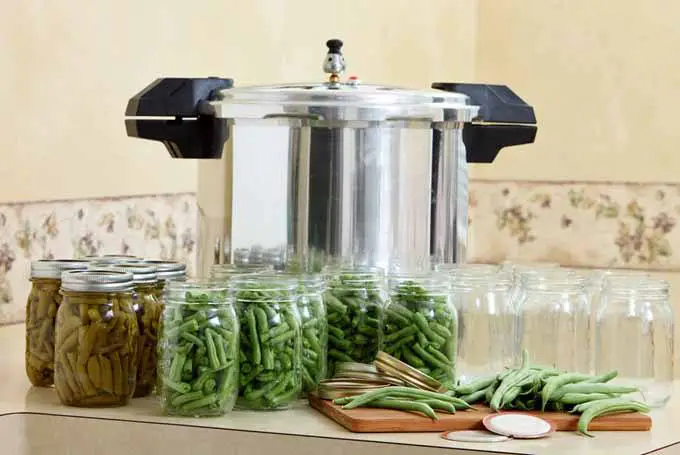Many people don’t realize just how much work goes into canning foods. If you are going to put something in a can, you will have to expose it to high enough temperatures for long enough to be sure that you have killed off all potentially harmful bacteria. Otherwise, you are at a severe risk of botulism.
If you want to avoid a serious illness that could result in grave complications or even death, you will go about your home canning correctly. Unfortunately, it doesn’t help that there is plenty of misinformation out there about how exactly you should can your food, and it has to do with pressure cookers and pressure canners.

As you may have guessed from the name, a pressure canner is a kitchen appliance that is somewhat similar to a pressure cooker, but it is more involved in the canning process. In today’s guide, we’ll be taking a look at some of the differences and similarities between these two types of appliances.
We have had several customers ask us some of the questions that we will cover in this article, and we figured that it was essential to clear up the confusion. If you are going to be canning food at home, you will want to go about it in the safest way possible so that you are not exposed to foodborne illness.
What Is The Difference Between A Pressure Cooker And A Canner?
A pressure canner is often also referred to as a canning pressure cooker because the two appliances are quite similar in purpose; the primary difference lies in their size. Where a pressure cooker is usually the size of a large pot, if not a little bigger, pressure canners, tend to have a significantly increased capacity.
Of course, with the increase in size also comes an augmentation in capability, and a pressure canner will be able to achieve much higher pressures (and therefore temperatures). This improved degree of effectiveness is key to why a pressure canner is safe to use for canning, and most pressure cookers are not.
How To Use A Pressure Canner
You may be wondering what exactly you need to do so that you can ensure that your canned goods are safe with a pressure canner, so let’s go over that as well. The larger size of a pressure canner not only helps it achieve higher pressures due to its thicker walls, but it also improves the capacity.
A more substantial internal volume is necessary for a pressure canner because you will be filling it with mason jars that are full of the foods that you will be canning. Keep in mind that the thicker walls of mason jars are necessary to ensure that they don’t crack under the high-pressure steam.
When the food is exposed to the high temperatures and steam that are typically only maintainable in a pressure canner, the risk of botulism is reduced to nearly zero. You may be wondering why you can’t do this in pressure cookers, and whether or not you can will depend on the model.

The vast majority of pressure cookers can’t achieve and maintain either the pressure or temperature required to kill off all of the bacteria that can grow in canned food. However, some models are more capable than others. A pressure cooker that can can is often known as a pressure cooker/canner.
Can You Cook In A Pressure Canner?
Since a pressure canner is essentially a massive pressure cooker, then it would make sense that you can cook in it. Whether or not you can use your pressure canner to prepare huge pressure-cooked meals depends on the model that you have installed in your home.
More modern pressure canners are often capable of doing everything that you can with a pressure cooker, but most older models are designed exclusively for canning. You won’t want to directly expose your food to an older pressure canner as they are often not made to be used in that way.
Some options will allow you to can and cook at the same time, like a pressure cooker for canning, like the kind that we mentioned earlier. Products like these are usually easier to reconfigure for your needed purpose, an integral feature for those who both can and pressure-cook their food.
A pressure cooker and canner combination can do both jobs if necessary, but there will always be those who argue that they are not as efficient as purpose-built models. This point may be valid, but for a slight decrease in efficiency, you won’t need to invest in a second (nearly identical) appliance.
In the end, your choice depends on what you will use more often. If you find yourself making canned goods most of the time, you should invest in a pressure canner that you may use to cook. If you prefer pressure cooking with occasional canning, you will want a pressure cooker with added canning capabilities.
The best advice that we can provide is knowing the type of product that you are investing in when you purchase it. Pay close attention to the instructions so that you know what you can and cannot do with your pressure cooker or canner as that may end up saving you from a hospital visit.

Botulism is a disease that is not to be taken lightly, and it is one of the only risks involved in canning your food. Both pressure cooking and pressure canning have their place in the kitchen, and whether or not you need a hybrid that can accomplish both, you will need to know what you’re doing.
Conclusion
We hope that this guide has given you all of the necessary information about pressure canning and its relation to pressure cooking. Thank you for taking the time to read this article, and feel free to leave any comments down below so that we can know your thoughts.
Resources:HealthLinkBCCDCFoodSafety




